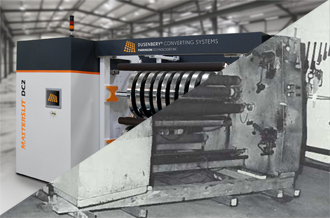by Joe Connelly , Product Manager - Winding and Slitting

Your slitter rewinder machine has been a real workhorse for decades. It’s gone through countless runs, and for the most part, it’s been useful to you. Unfortunately, it’s capabilities are outdated, parts need replacing, and you’re questioning whether it’s able to keep up with the production schedule. You may have rebuilt and upgraded some of the components, but some parts might not be worth the investment. It’s tempting to purchase a used machine. However, like buying a used vehicle, someone else’s problems will become yours. Plus, you still may need to make some upgrades to bring it up to today’s safety requirements. It might be time to think about something new.
What are some reasons why you may want to consider a new machine? Let’s take a look.
Safety - operating machinery can always carry the risk of injury. Large machines with moving parts, potential pinch points, and sharp edges are hazardous. That's why modern safety standardization efforts are developed to mitigate the risks by incorporating, for example, fixed or sliding barrier guarding, presence sensing electronic safeguards, and drive torque limitations. Modern machinery is engineered with safety standards in place before the machine makes it to the assembly floor. It should be the primary concern for any facility that uses this type of machinery, and that's why it is number one on this list.
Performance - like an aging athlete, a machine's performance will decline over the years. If you push an older slitter too hard, with thoughts of increasing its productivity, the machine may start to waver, and your plan will most likely backfire. It probably wasn't engineered to handle that level of production, whereas today’s slitters offer increased web widths, larger rewind diameters, and can operate at higher speeds thanks to modern industrial components from industry-leading manufacturers. Newer machinery also has productivity enhancements such as laser core and knife positioning systems.
Reliability – does your older machine suffer from constant adjustments? Have you experienced parts and components becoming loose and needing replacement? Do the knife settings need to be recalibrated each time you run a set? Do you need to stop the machine in the middle of a run? Is the slitter is becoming unreliable just when it becomes harder to find replacement parts? A slitting machine from a reputable manufacturer should be engineered with quality components without proprietary control boards or “black boxes,” to make it easily supported.
Efficiency – advancement in today’s technology includes components that use less power consumption, saving on monthly electric bills. Newer machinery can also include levels of automation that reduce setup times and measurement error, assist the operator in handling heavier loads, and provide overall increases in machine throughput.
Liability – any reputable machine manufacturer will evaluate the level of engineering needed to bring a piece of equipment up to the appropriate safety standards. However, safety isn’t the only factor that an OEM will evaluate. Other factors, such as the machine’s age, condition, and type, could make an OEM reluctant to provide upgrades or modifications. Learn more in our article about the Obligations of an OEM when Evaluating Legacy Equipment.
It’s a difficult decision to make financially. But in the long run, investing in a new machine will allow you the ability to increase production across a broader range of requirements and offer a higher level of safety for the operator and surrounding workers.
The Dusenbery brand is synonymous with slitter rewinders. For decades Dusenbery has been at the forefront of slitting technology. With the newer MasterSlit line, you’re getting the highest level of safety, reliability, efficiency, and performance. The MasterSlit DC2 duplex center slitter with a cantilevered design and larger diameter capacity offers standard web widths up to 72 inches and maximum operating speeds of 2,000 feet per minute. If you would like to learn more, please fill out the form below, and one of our team members will contact you.